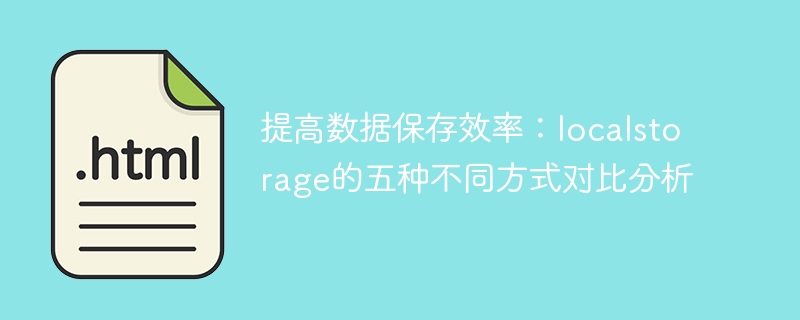

Improving data storage efficiency: Comparative analysis of five different methods of localstorage
Introduction:
In today's era of information explosion, data preservation and management have become Particularly important. In web development, we often need to save some data for use in different pages or sessions. One of the widely used data saving methods is to use localstorage.
Localstorage is a local storage mechanism provided by HTML5 that can permanently save data in the browser. It is based on key-value pair storage and supports the storage of simple data types, such as strings, numbers, and Boolean values. Next, we will conduct a comparative analysis of five different ways of using localstorage to improve data storage efficiency.
1. Single key-value pair storage
The simplest way to use localstorage is to store data as a single key-value pair. The sample code is as follows:
// 存储数据
localStorage.setItem("name", "John");
// 读取数据
var name = localStorage.getItem("name");
console.log(name); // 输出: JohnThis method is suitable for saving a single data item and is very simple and intuitive. But when multiple data items need to be saved, the use of localstorage will be inefficient.
2. Object Storage
In order to solve the shortcomings of a single key-value pair method, we can encapsulate multiple data items into one object and then store them in localstorage. The sample code is as follows:
// 存储数据
var user = {
name: "John",
age: 20,
gender: "male"
};
localStorage.setItem("user", JSON.stringify(user));
// 读取数据
var storedUser = JSON.parse(localStorage.getItem("user"));
console.log(storedUser.name); // 输出: JohnBy integrating multiple data items into one object, we can manage and access data more conveniently. But when there are many data items or the data structure is complex, this approach may lead to lengthy and difficult-to-maintain code.
3. Array storage
In addition to the object method, we can also store data items as an array. The sample code is as follows:
// 存储数据
var fruits = ["apple", "banana", "orange"];
localStorage.setItem("fruits", JSON.stringify(fruits));
// 读取数据
var storedFruits = JSON.parse(localStorage.getItem("fruits"));
console.log(storedFruits); // 输出: ["apple", "banana", "orange"]Using array mode to save data is suitable for scenarios where data order needs to be maintained or traversal operations are required. The disadvantage is that the data item cannot be accessed directly using the key, only through the index value.
4. Batch storage
When a large amount of data needs to be saved, calling setItem alone for storage will cause performance degradation. At this time, batch storage can be used to encapsulate the data into a large object and then store it. The sample code is as follows:
// 存储数据
var data = {
key1: value1,
key2: value2,
// ...
};
localStorage.setItem("data", JSON.stringify(data));
// 读取数据
var storedData = JSON.parse(localStorage.getItem("data"));
console.log(storedData); // 输出: { key1: value1, key2: value2, ... }The batch storage method is suitable for situations where the amount of data is large or all data items need to be accessed frequently. It can improve access efficiency and code simplicity.
5. Use third-party libraries
In addition to native localstorage, there are many third-party libraries that provide more advanced data storage mechanisms. For example, IndexedDB can be used to implement more complex query and indexing functions; PouchDB can be used to implement advanced functions such as data synchronization and offline access. Choosing a third-party library that suits your project needs will allow you to save and manage data more flexibly.
Conclusion:
This article conducts a comparative analysis of five different ways of using localstorage, including single key-value pair storage, object storage, array storage, batch storage and the use of third-party libraries. For different application scenarios and needs, we can choose the most suitable method to improve data storage efficiency.
However, it is worth noting that although localstorage has many advantages, it also has some limitations, such as storage capacity limitations, same-origin limitations, etc. In practical applications, we should comprehensively consider these factors and choose the most suitable storage solution. At the same time, in order to improve data security, it is recommended to encrypt the stored data.
In short, in the era of massive data, it is very important to improve data storage efficiency. By rationally choosing how to use localstorage, we can save and manage data more efficiently, providing better support for project development and user experience.
The above is the detailed content of Comparative analysis of five different ways of localstorage to improve data storage efficiency. For more information, please follow other related articles on the PHP Chinese website!




